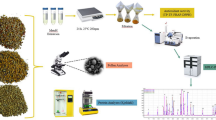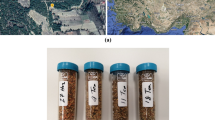Abstract
The aim of this study was to determine total amounts of phenolics and flavonoids, radical scavenging activities, and compositions of phenolic and volatile compounds in 14 samples of honeybee pollen collected in the Baltic region. Radical 2,2-diphenyl-1-picrylhydrazyl (DPPH) scavenging activities and total amounts of phenolics and flavonoids were evaluated using spectrophotometry. Volatiles from the headspace of the samples were analyzed using solid-phase microextraction (SPME) fiber coated with 100-μm polydimethylsiloxane layer, separated, and identified employing GC-mass spectrometry (MS). Forty-two volatiles were identified in the headspace. Nonanal (1.5–20.1 %), dodecane (1.2–-34.6 %), and tridecane (1.4–24.7 %) were found in all samples. Screening of phenolics and flavonoids was performed using high-performance liquid chromatography (HPLC) with electrochemical detection. 2-Hydroxycinnamic acid (43.4–179.9 μg/g), rutin (156.2–955.7 μg/g), and quercetin (24.0–529.8 μg/g) were detected in all tested samples. Total amounts of phenolic compounds and flavonoids varied between 24.1 and 45.5 mg/g, and 6.1 and 11.6 mg/g, respectively, expressed as rutin equivalents. The pollen extracts exhibited radical scavenging activity, which scattered widely in range of 7.1–39.2 mg/g, expressed as rutin equivalents. Radical scavenging activity correlated with the total content of phenolic compounds while correlation coefficient was 0.95. Chemometric evaluation was performed to classify the samples into clusters according to the observed data.




Similar content being viewed by others
References
Alissandrakis E, Tarantilis PA, Harizanis PC, Polissiou M (2007) Aroma investigation of unifloral Greek citrus honey using solid-phase microextraction coupled to gas chromatographic–mass spectrometric analysis. Food Chem 100(1):396–404
Bonvehí JS, Torrentó MS, Lorente EC (2001) Evaluation of polyphenolic and flavonoid compounds in honeybee-collected pollen produced in Spain. J Agric Food Chem 49:1848–1853
Borčić I, Radonić A, Grzunov K (1996) Comparison of the volatile constituents of propolis gathered in different regions of Croatia. Flavour Frag J 11:311–313
Campos MDGR, Sabatier S, Amiot MJ, Aubert S (1990) Characterization of flavonoids in three hive products: bee pollen, propolis, and honey. Planta Med 56:580–581
Campos M, Frigerio C, Lopes J, Bogdanov S (2010) What is the future of bee-pollen? J ApiProd ApiMed Sci 2:131–144
Carpes ST, Mourao GB, Alencar SD, Masson ML (2009) Chemical composition and free radical scavenging activity of Apis mellifera bee pollen from Southern Brazil. Braz J Food Technol 12(1/4):220–229
Carpes ST, de Alencar SM, Cabral ISR, Oldoni TLC, Mourão GB, Haminiuk CWI, da Luz CFP, Masson ML (2013) Polyphenols and palynological origin of bee pollen of Apis mellifera L. from Brazil. Characterization of polyphenols of bee pollen. CyTA-J Food 11(2):150–161
Chu Q, Tian X, Jiang L, Ye J (2007) Application of capillary electrophoresis to study phenolic profiles of honeybee-collected pollen. J Agric Food Chem 55(22):8864–8869
Chun OK, Kim DO, Smith N, Schroeder D, Han JT, Lee CY (2005) Daily consumption of phenolics and total antioxidant capacity from fruit and vegetables in the American diet. J Sci Food Agric 85(10):1715–1724
Fanali C, Dugo L, Rocco A (2013) Nano-liquid chromatography in nutraceutical analysis: determination of polyphenols in bee pollen. J Chromatogr A 1313:270–274
Feás X, Vázquez-Tato MP, Estevinho L, Seijas JA, Iglesias A (2012) Organic bee pollen: botanical origin, nutritional value, bioactive compounds, antioxidant activity and microbiological quality. Molecules 17(7):8359–8377
Ferreres F, Pereira DM, Valentão P, Andrade PB (2010) First report of non-coloured flavonoids in Echium plantagineum bee pollen: differentiation of isomers by liquid chromatography/ion trap mass spectrometry. Rapid Commun Mass Sp 24(6):801–806
Freire KRL, Lins ACS, Dórea MC, Santos FAR, Camara CA, Silva TMS (2012) Palynological origin, phenolic content, and antioxidant properties of honeybee-collected pollen from Bahia, Brazil. Molecules 17:1652–1664
Ghica ME, Brett AMO (2005) Electrochemical oxidation of rutin. Electroanal 17(4):313–318
Graikou K, Kapeta S, Aligiannis N, Sotiroudis G, Chondrogianni N, Gonos E, Chinou I (2011) Chemical analysis of Greek pollen-antioxidant, antimicrobial and proteasome activation properties. Chem Centr J 5:1–9
Kaškonienė V, Venskutonis PR, Čeksterytė V (2008) Composition of volatile compounds of honey of various floral origin and beebread collected in Lithuania. Food Chem 111(4):988–997
Kaškonienė V, Maruška A, Kornyšova O, Charczun N, Ligor M, Buszewski B (2009) Quantitative and qualitative determination of phenolic compounds in honey. Chemine Technologija 3:74–80
Kaškonienė V, Kaškonas P, Maruška A, Kubilienė L (2014) Chemometric analysis of volatiles of propolis from different regions using static headspace GC-MS. Cent Eur J Chem 12:736–746
Küpeli AE, Orhan DD, Gürbüz I, Yesilada E (2010) In vivo activity assessment of a “honey-bee pollen mix” formulation. Pharm Biol 48(3):253–259
LeBlanc BW, Davis OK, Boue S, DeLucca A, Deeby T (2009) Antioxidant activity of Sonoran Desert bee pollen. Food Chem 115(4):1299–1305
Leja M, Mareczek A, Wyżgolik G, Klepacz-Baniak J, Czekońska K (2007) Antioxidative properties of bee pollen in selected plant species. Food Chem 100(1):237–240
Lušić D, Koprivnjak O, Ćurić D, Sabatini AG, Conte LS (2007) Volatile profile of Croatian lime tree (Tilia sp.), fir honeydew (Abies alba) and sage (Salvia officinalis) honey. Food Technol Biotech 45(2):156–165
Mărghitaş LA, Stanciu OG, Dezmirean DS, Bobiş O, Popescu O, Bogdanov S, Campos MG (2009) In vitro antioxidant capacity of honey bee-collected pollen of selected floral origin harvested from Romania. Food Chem 115(3):878–883
Maruyama H, Sakamoto T, Araki Y, Hara H (2010) Anti-inflammatory effect of bee pollen ethanol extract from Cistus sp. of Spanish on carrageenan-induced rat hind paw edema. BMC Complem Altern Med 10(1)
Mikašauskaitė J, Ragažinskienė O, Maruška A (2013) Variation of total amount of phenolic compounds, radical scavenging activity and volatile compounds of Liriodendron tulipifera L. and Ginkgo biloba L. leaves extracts during different vegetation periods. Biologija 59(2):175–186
Morais M, Moreira L, Feás X, Estevinho LM (2011) Honeybee-collected pollen from five Portuguese Natural Parks: palynological origin, phenolic content, antioxidant properties and antimicrobial activity. Food Chem Toxicol 49(5):1096–1101
Negri G, Teixeira EW, Florencio Alves MLTM, Moreti ACDCC, Otsuk IP, Borguini RG, Salatino A (2011) Hydroxycinnamic acid amide derivatives, phenolic compounds and antioxidant activities of extracts of pollen samples from southeast Brazil. J Agric Food Chem 59:5516–5522
Pasini F, Gardini S, Marcazzan GL, Caboni MF (2013) Buckwheat honeys: screening of composition and properties. Food Chem 141:2802–281
Šarić A, Balog T, Sobočanec S, Kušić B, Šverko V, Rusak G, Likić S, Bubalo D, Pinto B, Reali D, Marotti T (2009) Antioxidant effects of flavonoid from Croatian Cystus incanus L. rich bee pollen. Food Chem Toxicol 47:547–554
Simionatto E, Facco AT, Morel AF, Giacomelli SR, Linares CEB (2012) Chiral analysis of monoterpenes in volatile oils from propolis. J Chil Chem Soc 57:1240–1243
Stankevičius M, Akuņeca I, Jãkobsone I, Maruška A (2011) Comparative analysis of radical scavenging and antioxidant activity of phenolic compounds present in everyday use spice plants by means of spectrophotometric and chromatographic methods. J Sep Sci 34(11):1261–1267
Tananaki C, Thrasyvoulou A, Giraudel JL, Montury M (2007) Determination of volatile characteristics of Greek and Turkish pine honey samples and their classification by using Kohonen self organising maps. Food Chem 101(4):1687–1693
Tohamy AA, Abdella EM, Ahmed RR, Ahmed YK (2014) Assessment of anti-mutagenic, anti-histopathologic and antioxidant capacities of Egyptian bee pollen and propolis extracts. Cytotechnology 66:283–297
Van Vuuren SF, Viljoen AM (2007) Antimicrobial activity of limonene enantiomers and 1,8-cineole alone and in combination. Flavour Fragr J 22:540–544
Vasco C, Ruales J, Kamal-Eldin A (2008) Total phenolic compounds and antioxidant capacities of major fruits from Ecuador. Food Chem 111(4):816–823
Acknowledgments
Authors would like to thank Apiproduktai, Ltd., for providing of the bee pollen samples.
Author Contributions
V. Kaškonienė was responsible for the experiments, result interpretation, and preparation of the paper concerning chemical part. G. Ruočkuvienė performed SPME-GC-MS and spectrophotometric and HPLC analyses. P. Kaškonas performed statistical mining, interpreted the classification results, and prepared the paper part about chemometric analysis. I. Akuneca helped in qualitative and quantitative analysis with HPLC. A. Maruška helped in experimental design and interpretation of the results. All authors contributed equally.
Conflict of Interest
Vilma Kaškonienė declares that she has no conflict of interest. Geralda Ruočkuvienė declares that she has no conflict of interest. Paulius Kaškonas declares that he has no conflict of interest. Ieva Akuneca declares that she has no conflict of interest. Audrius Maruška declares that he has no conflict of interest. This article does not contain any studies with human or animal subjects.
Author information
Authors and Affiliations
Corresponding author
Rights and permissions
About this article
Cite this article
Kaškonienė, V., Ruočkuvienė, G., Kaškonas, P. et al. Chemometric Analysis of Bee Pollen Based on Volatile and Phenolic Compound Compositions and Antioxidant Properties. Food Anal. Methods 8, 1150–1163 (2015). https://doi.org/10.1007/s12161-014-9996-2
Received:
Accepted:
Published:
Issue Date:
DOI: https://doi.org/10.1007/s12161-014-9996-2




